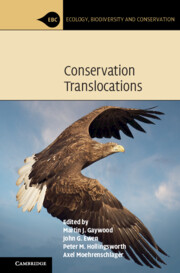Book contents
- Frontmatter
- Dedication
- Contents
- Contributors
- Foreword
- Preface
- Acknowledgements
- Part I Conservation Translocations: Getting Started
- 1 Moving Species: Reintroductions and Other Conservation Translocations
- 2 Conservation Translocations: Planning and the Initial Appraisal
- Part II Conservation Translocations: The Key Issues
- Part III Conservation Translocations: Looking to the Future
- Part IV Case Studies
- Index
- Plates
2 - Conservation Translocations: Planning and the Initial Appraisal
from Part I - Conservation Translocations: Getting Started
Published online by Cambridge University Press: 07 December 2022
- Frontmatter
- Dedication
- Contents
- Contributors
- Foreword
- Preface
- Acknowledgements
- Part I Conservation Translocations: Getting Started
- 1 Moving Species: Reintroductions and Other Conservation Translocations
- 2 Conservation Translocations: Planning and the Initial Appraisal
- Part II Conservation Translocations: The Key Issues
- Part III Conservation Translocations: Looking to the Future
- Part IV Case Studies
- Index
- Plates
Summary
Although conservation translocations always aim to result in ‘conservation benefit’ for a species or ecosystem, there are many motivations and contexts in which people undertake conservation translocations. Establishing a need for translocations involves considering other ways to deliver the ‘conservation benefit’ to a species or ecosystem. Typically, translocations are initiated alongside other conservation measures. Destination sites must be carefully selected based on more than just vegetation type; attention must be paid to climate, biotic interactions, and other species’ requirements for survival. Socio-economic risks and benefits and legislative constraints should also be considered when evaluating destination sites. Translocated plants, animals, or fungi may be sourced from in situ or ex situ populations, or a combination of the two. Ideally, source populations are those that can support the removal of individuals for translocation without negative consequences for individuals that remain in the wild. It also helps to have ecological similarity between source and destination sites when using wild individuals. Releases should only occur where the original cause of extirpation/decline has been minimised. The choice of one or several sites, and the possibility of several releases over multiple timepoints should be considered, perhaps using pilot releases to evaluate suitability. Monitoring is crucial to being able to report the outcome of the conservation translocation but, perhaps more importantly, allows the translocation team to adapt to changes in status and may prompt the implementation of an exit strategy. Sharing monitoring results is important for others to benefit from lessons learnt. Seek as much advice as you can in the planning phases and build a team that can deliver the various components of the project.
Keywords
- Type
- Chapter
- Information
- Conservation Translocations , pp. 43 - 74Publisher: Cambridge University PressPrint publication year: 2022

